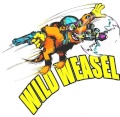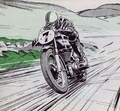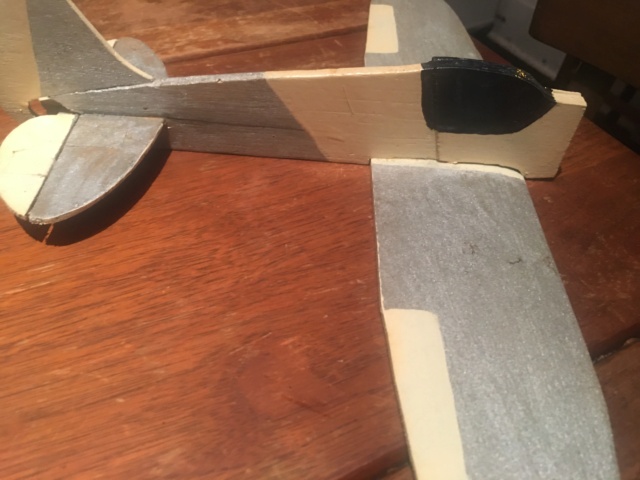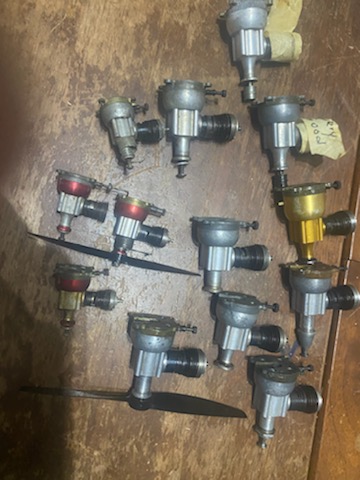Log in
Search
Latest topics
» Duende V model from RC Model magazine 1983.by MauricioB Today at 3:46 pm
» A Little 400 Mile Hop for Some Memory Lane Stuff, and to Hit a Swap Meet.
by Kim Today at 12:35 pm
» Free Flight Radio Assist
by rdw777 Today at 9:28 am
» Happy 77th birthday Andrew!
by Kim Today at 9:18 am
» Promote the forum with flyers!
by Admin Today at 1:35 am
» Roger Harris revisited
by rsv1cox Yesterday at 7:34 pm
» Engine choice
by GallopingGhostler Yesterday at 4:03 pm
» My N-1R build log
by roddie Yesterday at 9:19 am
» Night flying at Walters RC park
by 1975 control line guy Sun Nov 24, 2024 7:29 pm
» Cox films/videos...
by GallopingGhostler Sun Nov 24, 2024 7:07 pm
» Cox 020 PeeWee rebuild questions
by LooseSpinner99 Sun Nov 24, 2024 6:13 pm
» Did you spot the Cox engine in this NASA research video?
by balogh Sun Nov 24, 2024 5:08 pm
Cox Engine of The Month
Baby bee basics
Page 1 of 1
 Baby bee basics
Baby bee basics
Hello everyone,
I’ve inherited many complete baby bees and lots of bits and pieces. I would estimate 25 together engines and just as many if not more tanks, cylinders, pistons, crank cases ect. From all eras of production.
I’m excited to get back into the family tradition of spinning is a circle for fun. We always had basic plank park flyers nothing fancy. This was 25+ years ago when I was too young to pay attention to all the details of what made things go.
I’ve got a few good runners fairly easily by cleaning and changing gaskets. However I want to get as many engines as I can to give complete planes to all the kids in the family. That being said I have a few questions.
When assembling an engine what’s the best way to tell if it’s a good piston/cylinder combo? Listen for the pop when turning the prop?
How do I know if the piston needs reset? Should I assume they all do?
How do I evaluate the condition of a needle valve?
I think that’s it for now. Thanks for your time and knowledge.
RSK
I’ve inherited many complete baby bees and lots of bits and pieces. I would estimate 25 together engines and just as many if not more tanks, cylinders, pistons, crank cases ect. From all eras of production.
I’m excited to get back into the family tradition of spinning is a circle for fun. We always had basic plank park flyers nothing fancy. This was 25+ years ago when I was too young to pay attention to all the details of what made things go.
I’ve got a few good runners fairly easily by cleaning and changing gaskets. However I want to get as many engines as I can to give complete planes to all the kids in the family. That being said I have a few questions.
When assembling an engine what’s the best way to tell if it’s a good piston/cylinder combo? Listen for the pop when turning the prop?
How do I know if the piston needs reset? Should I assume they all do?
How do I evaluate the condition of a needle valve?
I think that’s it for now. Thanks for your time and knowledge.
RSK

Rskeifer- Beginner Poster

- Posts : 6
Join date : 2021-04-16
 Re: Baby bee basics
Re: Baby bee basics
Welcome to one of the best forums on the web...poke around there is a LOT more here than just Cox engines.
Boats, cars, planes, trains, guns, dogs, cats, bears n birds, weather, and all sort of interesting stuff... we strive to be insightful, helpful, and seriously keep any politics to friendly exchanges of thoughts...very well self moderated because we mostly like and appreciate every member.
Our leader Jacob and others have used us to send "Traveling" engines around the world to members who wrote and photographed them in all sorts of places with a smidgen of local sights and history.
Not so much lately but we used to have fun contests such as the Tach Race, where we sent engines to a CONTEST director who ran each on same fuel and prop to see who's engines had highest RPM in each category then sent the engine back to the owner. Winner got a prize, Very fun
Somebody will answer your questions shortly
Boats, cars, planes, trains, guns, dogs, cats, bears n birds, weather, and all sort of interesting stuff... we strive to be insightful, helpful, and seriously keep any politics to friendly exchanges of thoughts...very well self moderated because we mostly like and appreciate every member.
Our leader Jacob and others have used us to send "Traveling" engines around the world to members who wrote and photographed them in all sorts of places with a smidgen of local sights and history.
Not so much lately but we used to have fun contests such as the Tach Race, where we sent engines to a CONTEST director who ran each on same fuel and prop to see who's engines had highest RPM in each category then sent the engine back to the owner. Winner got a prize, Very fun
Somebody will answer your questions shortly

fredvon4- Top Poster


Posts : 4012
Join date : 2011-08-26
Age : 69
Location : Lampasas Texas
 Re: Baby bee basics
Re: Baby bee basics
Welcome to the forum, RSK. If you have a question related to COX engines, someone on this forum will have the answer.
As far as parts go, if you have not found them yet, two of the main suppliers of all things COX are:
EX Model Engines - US based
and
COX International - Canada
As far as parts go, if you have not found them yet, two of the main suppliers of all things COX are:
EX Model Engines - US based
and
COX International - Canada
 Re: Baby bee basics
Re: Baby bee basics
Hello, and welcome to the forum...not wanting to assume the position of an engine guru here, but trying to answer your points:
1. Piston/cylinder combo is good or bad. Your most powerful stock cylinder on a reedie is the No. 1 (you see that stamped just under the exhaust port) It is not that No 2 is much weaker, but will generate a few hundreds less rpm. When the engine is "wet" in fuel, you are not supposed to see too many bubbles in the exhaust opening when the engine is cranked slowly by hand towards the top dead center. This will mean the compression is just good, or -without bubbles - excellent...Old stock cylinders like the thin wall were made with tapered bore that, if properly handled, retained compression longer than later production runs. If the engine has been used for long in humid area, the cylinder wall will show some brownish, varnish build up. While there are de-varnisher brushes sold here and there, I do not recommend varnish removal by any mechanical way: try using a kitchen cold grease remover spray sold in household shops. Spray it on the cylinder internal wall, let it work there for a minute, then use a cotton bud to remove the varnish..works good in my experience.
2. A piston needs reset once the "play" of the conrod is excessive. There are some suggested , still acceptable gaps to describe this (0.001 through 0.003 inches as per the resetting tool instruction) , but because it is not easy to measure the gap with everyday tools, it is typically a subjective feel that can decide if the setting is necessary. With the glow head loose, crank the piston to the top dead center and tighten the glow head. The crankshaft will show a free turn play of plus minus 10 or so degree to the right and to the left, before the piston moves from the TDC , showing a gap, that is partly related to the fit of the conrod to the balljoint, and partly to the crank-pin to conrod connection fit. I would say that more than 10 degree to the right and left calls for a slight reset of the conrod balljoint.
3. Visually check the needle valve, if its tip is broken or intact. Many of us pull a fuel tube on the NV and over the threaded nipple to prevent unwanted air ingress into the venturi along the NV threads. This is recommended with rather used engines only. NV-s on new engines will most likely not leak
This is just a very small fraction of all the know-how accumulated here on CEF, quite arbitrarily picked by myself...search for key words here on CEF for a plethora of information on very interesting subjects.
1. Piston/cylinder combo is good or bad. Your most powerful stock cylinder on a reedie is the No. 1 (you see that stamped just under the exhaust port) It is not that No 2 is much weaker, but will generate a few hundreds less rpm. When the engine is "wet" in fuel, you are not supposed to see too many bubbles in the exhaust opening when the engine is cranked slowly by hand towards the top dead center. This will mean the compression is just good, or -without bubbles - excellent...Old stock cylinders like the thin wall were made with tapered bore that, if properly handled, retained compression longer than later production runs. If the engine has been used for long in humid area, the cylinder wall will show some brownish, varnish build up. While there are de-varnisher brushes sold here and there, I do not recommend varnish removal by any mechanical way: try using a kitchen cold grease remover spray sold in household shops. Spray it on the cylinder internal wall, let it work there for a minute, then use a cotton bud to remove the varnish..works good in my experience.
2. A piston needs reset once the "play" of the conrod is excessive. There are some suggested , still acceptable gaps to describe this (0.001 through 0.003 inches as per the resetting tool instruction) , but because it is not easy to measure the gap with everyday tools, it is typically a subjective feel that can decide if the setting is necessary. With the glow head loose, crank the piston to the top dead center and tighten the glow head. The crankshaft will show a free turn play of plus minus 10 or so degree to the right and to the left, before the piston moves from the TDC , showing a gap, that is partly related to the fit of the conrod to the balljoint, and partly to the crank-pin to conrod connection fit. I would say that more than 10 degree to the right and left calls for a slight reset of the conrod balljoint.
3. Visually check the needle valve, if its tip is broken or intact. Many of us pull a fuel tube on the NV and over the threaded nipple to prevent unwanted air ingress into the venturi along the NV threads. This is recommended with rather used engines only. NV-s on new engines will most likely not leak
This is just a very small fraction of all the know-how accumulated here on CEF, quite arbitrarily picked by myself...search for key words here on CEF for a plethora of information on very interesting subjects.

balogh- Top Poster



Posts : 4961
Join date : 2011-11-06
Age : 66
Location : Budapest Hungary
 Re: Baby bee basics
Re: Baby bee basics
i'd recommend setting up Direct Deposit account with both of our wonderful vendors.
just get that our of the way, and the addiction will be so much easier.
there are a BUHZILLION ways to get fuels, including many well written formulas on this very discussion group.
but for beginners (returners) the easiest way is Sig Champion 35% (i recommend buying a pint to start)
https://sigmfg.com/collections/fuel/products/sig-champion-fuel?variant=380738928649
Cleaning... depends on how long they have been sitting, how much fuel was left in em, etc.. Are they stuck, are they gunk-ey with castor.. blah blah blah
you can find TONS of cleaning info by typing clean in the search bar. I find I learn more every time I dissemble some dirty engines. best advice? there are no shortcuts, take your time, be careful.
clean em up a little, put some fuel in em and fly em!
lets see pix!
just get that our of the way, and the addiction will be so much easier.
there are a BUHZILLION ways to get fuels, including many well written formulas on this very discussion group.
but for beginners (returners) the easiest way is Sig Champion 35% (i recommend buying a pint to start)
https://sigmfg.com/collections/fuel/products/sig-champion-fuel?variant=380738928649
Cleaning... depends on how long they have been sitting, how much fuel was left in em, etc.. Are they stuck, are they gunk-ey with castor.. blah blah blah
you can find TONS of cleaning info by typing clean in the search bar. I find I learn more every time I dissemble some dirty engines. best advice? there are no shortcuts, take your time, be careful.
clean em up a little, put some fuel in em and fly em!
lets see pix!

cstatman- Platinum Member



Posts : 568
Join date : 2021-02-17
Age : 60
Location : San Jose, CA
 Re: Baby bee basics
Re: Baby bee basics
 to the forum, @Rskeifer!
to the forum, @Rskeifer!There are a few here who still fly those solid balsa wing flyers here, some the Walt Musciano Scientific hollow log carved fuselage half-A jobs. And, there are a few who fly combat plank flyers, too.Rskeifer wrote:I’m excited to get back into the family tradition of spinning is a circle for fun. We always had basic plank park flyers nothing fancy. This was 25+ years ago when I was too young to pay attention to all the details of what made things go.
You are definitely a collector and you fit in well with our forum here! When I joined this forum 9 years ago, I had may be a half dozen .049 Cox engines, and a small handful of others (OS, Enya, Fuji, Testors, Fox, .099 to .40). Now I have almost 80 engines, with over a dozen Coxes, at least 20 as half-A's. They are addicting.Rskeifer wrote:I’ve inherited many complete baby bees and lots of bits and pieces. I would estimate 25 together engines and just as many if not more tanks, cylinders, pistons, crank cases etc. From all eras of production.
If engine is dry and hasn't been used in a while, I use a light drop of lightweight machine oil, a drop in the exhaust port to oil the piston, a drop or two in the venturi entrance, which is sucked in when flipping the prop, and a drop on the prop drive washer to crankcase crack, to oil the crankshaft front. A couple of flips to spread lubrication works for me. Glow head should be sufficiently tight and seated so there are no compression leaks around the head. When you flip it, it should have good, strong compression. A worn engine, you will be able to see a lot of oil bubbling as the piston is moved toward top-dead-center, with very weak compression.Rskeifer wrote:I’ve got a few good runners fairly easily by cleaning and changing gaskets. However I want to get as many engines as I can to give complete planes to all the kids in the family. That being said I have a few questions. When assembling an engine what’s the best way to tell if it’s a good piston/cylinder combo? Listen for the pop when turning the prop?
If engine has some mileage on it and still seems a little sluggish when flipping after oiling, could be that the engine was run on mostly Castor lubricated glow fuel, and has varnish build up. I follow the old Cox method of disassembly removing the piston (can leave the cylinder mounted on the crankcase). Some careful scrubbing with fine steel wool removes the varnish from the cylinder surfaces, a light touch on the piston too, then reassemble.
There are a lot of philosophies about what oils to use. Some use automatic transmission oil because they say that it does not dry out in storage, some a mix with Marvel Mystery Oil. I haven't gotten too scientific, but that is me, a lover of simplicity. However, some take collecting and ultimate performance much more seriously than me, so regarding my methodologies, there is a lot of room to play in.

I respect their opinions, being the sport modeller that I am, my methodologies may be less than perfect, but for the shade tree mechanic, suit me fine.
Over time, the socket fit will loosen. This is normal. Unless the engine is new and never run, out of the package, it is worthwhile to reset the under piston ball joint. This I usually do after a season of flying. Problem is that on very high time engines, it can finally come loose, with catastrophic results. It is not hard to imagine what can happen at 15,000 RPM on even a sport engine.Rskeifer wrote:How do I know if the piston needs reset? Should I assume they all do?
Since parts sources are slowly drying up (Cox engine parts are mostly from new-but-old-stock (NOS), once gone, they are gone), most pay better care to their engines. This is different than it was in the past. I remember back in the 1970's, stopping by either Montgomery Ward or Sears department stores, who sold Cox engine parts in their toy / hobby section, and picking up extra cylinder / piston sets, needle valves, starter springs, etc. Then in the 1980's, getting them from the local hobby shops. All that has changed.
If it is seated in the engine, turns freely without binding, it is probably okay. You can remove and do a physical examination of it. Needle tip should be intact, straight and its full length. Ex Model Engines and Cox International Canada have some replacement needles. There are different threads depending on model. There is fine thread and courser thread. These will need to matched up to fit perfectly.Rskeifer wrote:How do I evaluate the condition of a needle valve?

GallopingGhostler- Top Poster


Posts : 5731
Join date : 2013-07-13
Age : 70
Location : Clovis NM or NFL KC Chiefs
 Re: Baby bee basics
Re: Baby bee basics
Thanks for the warm welcome and quick knowledge responses guys.
If a cylinder/ piston combo is worn is there any hope? What’s the week point the cylinder? Might a piston work in another cylinder or could a different combo of both give a better result?
There’s a lot of bits and pieces here. Not that we would ever throw any of it doesn’t seem in our blood. I’m just wondering how to attack these parts when I get to them. Fortunately I’m blessed by the fact that there are enough intact engines it’ll be a while before I get to them. The complete sets had been put away marked, very good, good and bad. I trust this opinion as baby bees was about the only thing we flew from at least the early 80s on.
Pics coming soon.
If a cylinder/ piston combo is worn is there any hope? What’s the week point the cylinder? Might a piston work in another cylinder or could a different combo of both give a better result?
There’s a lot of bits and pieces here. Not that we would ever throw any of it doesn’t seem in our blood. I’m just wondering how to attack these parts when I get to them. Fortunately I’m blessed by the fact that there are enough intact engines it’ll be a while before I get to them. The complete sets had been put away marked, very good, good and bad. I trust this opinion as baby bees was about the only thing we flew from at least the early 80s on.
Pics coming soon.

Rskeifer- Beginner Poster

- Posts : 6
Join date : 2021-04-16
 Re: Baby bee basics
Re: Baby bee basics
I just wanted to add a correction to what I stated. Reason why, is that it has been a while since I really messed with Cox engines. And that has to do with devarnishing the cylinders. The early cylinders are tapered, which makes extracting the piston out of the top through the glow plug hole difficult, if not impossible. I'd appreciate more input in this, because in was back in the 1970's and 1980s that I put considerably more mileage on the Coxes.
(Well, I'm not totally telling the truth, because about 5 years ago, I restored and tested my son's 1960's vintage Cox .049 Babe Bee field find in the 1990's. Posted photos in May 2022 Cox Engine of the Month Contest.)
Others here, are more adept, as they mess with these regularly. I ruined a number of thin wall cylinders without the flats on the top to put a Cox wrench to. One had to put the wrench in the exhaust port area. Given the softer steel used, sometimes I nicked the opening creating a burr into the combustion chamber, a no-no. Sometimes, I was able to carefully file this off. But most of the time, because parts back then were readily available, I'd just buy a new cylinder with matching piston.
This is why I have a Pee Wee without a cylinder, because I ham fisted the cylinder ruining it.
Plus, where I live, the half-A's don't do as well because of our windy city situation all year round. We have very few trees on this desert high plain. (The largest hill in town are the speed bumps at the Hobby Lobby parking lot.) Thus, I fly the larger aircraft .15 and up, sometimes .09's.
Also, I am recovering from back surgery, have had serious back problems over the past couple years, and so this has limited my outdoor activities. So if you're wondering why I haven't done much flying, this is why.
Because you have so many engines, you could of course restore them all to running condition given time, money, and patience. But in my case, I do have a number of parts engines, because it is not worth my while to restore them due to cost and priorities.
There's a lot of leeway, and we all look forward to the seeing your collection and experiences in bringing them back to life, plus getting family members involved.
(Well, I'm not totally telling the truth, because about 5 years ago, I restored and tested my son's 1960's vintage Cox .049 Babe Bee field find in the 1990's. Posted photos in May 2022 Cox Engine of the Month Contest.)
Others here, are more adept, as they mess with these regularly. I ruined a number of thin wall cylinders without the flats on the top to put a Cox wrench to. One had to put the wrench in the exhaust port area. Given the softer steel used, sometimes I nicked the opening creating a burr into the combustion chamber, a no-no. Sometimes, I was able to carefully file this off. But most of the time, because parts back then were readily available, I'd just buy a new cylinder with matching piston.
This is why I have a Pee Wee without a cylinder, because I ham fisted the cylinder ruining it.
Plus, where I live, the half-A's don't do as well because of our windy city situation all year round. We have very few trees on this desert high plain. (The largest hill in town are the speed bumps at the Hobby Lobby parking lot.) Thus, I fly the larger aircraft .15 and up, sometimes .09's.
Also, I am recovering from back surgery, have had serious back problems over the past couple years, and so this has limited my outdoor activities. So if you're wondering why I haven't done much flying, this is why.
Because you have so many engines, you could of course restore them all to running condition given time, money, and patience. But in my case, I do have a number of parts engines, because it is not worth my while to restore them due to cost and priorities.
There's a lot of leeway, and we all look forward to the seeing your collection and experiences in bringing them back to life, plus getting family members involved.

GallopingGhostler- Top Poster


Posts : 5731
Join date : 2013-07-13
Age : 70
Location : Clovis NM or NFL KC Chiefs
 Re: Baby bee basics
Re: Baby bee basics
The family got together last weekend. Much fun was had.
I waited until the yard was cleaned up on Sunday to attempt flying. Some family had cleared out but the remaining sons and a few grandsons of Dick Keifer All got at least a few spins in. Planes that haven’t seen the air in 20 years got up. Only one casualty.
In our haste to get in the air I must have forgot these guys lean out in the air. It took pre then a few attempts to get some good runs. Overall successful will be better every time.
Thinking about giving it a go solo tomorrow. Just need to grab a bath mat.
I waited until the yard was cleaned up on Sunday to attempt flying. Some family had cleared out but the remaining sons and a few grandsons of Dick Keifer All got at least a few spins in. Planes that haven’t seen the air in 20 years got up. Only one casualty.
In our haste to get in the air I must have forgot these guys lean out in the air. It took pre then a few attempts to get some good runs. Overall successful will be better every time.
Thinking about giving it a go solo tomorrow. Just need to grab a bath mat.

Rskeifer- Beginner Poster

- Posts : 6
Join date : 2021-04-16
 Re: Baby bee basics
Re: Baby bee basics
Welcome to the CEF ! Good to hear your getting some of the Family involved in the hobby and your getting some runs and flight time , what kind of planes are you fling ? 





getback- Top Poster



Posts : 10444
Join date : 2013-01-18
Age : 67
Location : julian , NC
 Re: Baby bee basics
Re: Baby bee basics
Welp, The busy season at work along with moving house has gotten in the way of fun. The good news is that summer is winding down and the new place has a ton of space for a workshop something I would have never had where we currently are.
Thanks for all the advice everyone. To answer the most recent question, Plank park flyers of various designs on 32ish lines. Some are more epoxy and glue than wood at this point. Over the winter I'm going to finish a few that never flew and trace some older proven winners.
A few pictures to wet the appetite. I'll post more if you all want.

Thanks for all the advice everyone. To answer the most recent question, Plank park flyers of various designs on 32ish lines. Some are more epoxy and glue than wood at this point. Over the winter I'm going to finish a few that never flew and trace some older proven winners.
A few pictures to wet the appetite. I'll post more if you all want.


Rskeifer- Beginner Poster

- Posts : 6
Join date : 2021-04-16

Rskeifer- Beginner Poster

- Posts : 6
Join date : 2021-04-16
 Re: Baby bee basics
Re: Baby bee basics


 Never to many pics. Nice looking bunch you got there ! I can see were you could bee a little busy with moving and all , Great to hear your going to a place were a model shop will bee in the plans
Never to many pics. Nice looking bunch you got there ! I can see were you could bee a little busy with moving and all , Great to hear your going to a place were a model shop will bee in the plans 



getback- Top Poster



Posts : 10444
Join date : 2013-01-18
Age : 67
Location : julian , NC
 Re: Baby bee basics
Re: Baby bee basics
WELCOME TO THE CEF!!!!!
Great to have you here!!!!
Great to have you here!!!!

Kim- Top Poster




Posts : 8630
Join date : 2011-09-06
Location : South East Missouri
 Re: Baby bee basics
Re: Baby bee basics
Love your pictures. Welcome to the forum.
Bob
Bob

rsv1cox- Top Poster




Posts : 11257
Join date : 2014-08-18
Location : West Virginia
Page 1 of 1
Permissions in this forum:
You cannot reply to topics in this forum

 Rules
Rules













